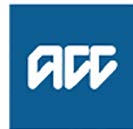
22 October 2020
Paul White
[FYI request #13883 email]
Tēnā koe Paul
Your Official Information Act request, reference: GOV-007089
Thank you for your email of 29 September 2020, asking for the following information, which we are
responding to under the Official Information Act 1982 (the Act):
Please provide the following policies;
•
Vocational independence About Vocational Independence
•
Vocational independence About Vocational Independence Deterioration Policy
•
Vocational independence Complex and Standard Vocational Independence Assessments
•
Vocational independence Eligibility for vocational independence
•
Vocational independence Vocational Independence Assessments (VIOA/VIMA) [Policy]
•
Vocational independence Vocational Independence Deterioration and Surgery Policy
•
Vocational independence Vocational Independence Medical Assessment Policy
•
Vocational independence Vocational Independence Occupational Assessment Policy
Our policies
Please find attached the active ACC policies that have replaced the eight policies requested. This is
explained in the following section.
• About Vocational Independence
• About Vocational Independence Deterioration Policy
• Vocational Independence Medical Assessment Service Page
• Vocational Independence Assessments (VIOA/VIMA) [Policy]
• Vocational Independence Deterioration and Surgery Policy
Updated policies
In our previous response to you dated 15 June 2020 (GOV-004811), we provided a list of ACC policies
and processes. That list was retrieved from the ACC policy and process system, Promapp, which was still
in a transitional phase from the previous system, CHIPS. The below policies were in the process of being
reviewed and merged with either other policy pages or new policy pages that had been established.
Subsequently, the following policies you requested are no longer in use and have been integrated with
the policies that are attached.


GOV-007089
The
Eligibility for Vocational Independence Policy has been integrated into the
About Vocational
Independence Policy.
The Complex and Standard Vocational Independence Assessments Policy has been archived and is no
longer in a policy document. Information on the topic is now held in the attached service page, the
Vocational Independence Medical Assessment Service Page.
The Vocational Independence Medical Assessment Policy and Vocational Independence Occupational
Assessment Policy have been merged with the
Vocational Independence Assessments (VIOA/VIMA)
Policy.
Withheld information
Certain information has been withheld under section 9(2)(a) of the Act to protect the privacy of named
individuals. In doing so, we considered the public interest in making the information available and have
determined that it does not outweigh the need to protect the privacy of these persons.
Who to contact
If you have any questions, you can email me at
[email address].
If you are not happy with this response, you have the right to make a complaint to the Ombudsman.
Information about how to do this is available at
www.ombudsman.parliament.nz or by phoning 0800
802 602.
Nāku iti noa, nā
Sasha Wood
Manager Official Information Act Services
Government Engagement & Support
Accident Compensation Corporation
Page 2 of 2
 About Vocational Independence v7.0
Summary
b
About Vocational Independence v7.0
Summary
b These assessments will consider:
• whether the VR provided has met the client’s needs
Objective
• what types of work are suitable for the client based on
This policy defines vocational independence. Use this policy to
their skills gained through education, training or expe-
understand:
rience
1. What is vocational independence
• how the client’s injury is affecting their ability to work
2. Determining Vocational Independence
• whether they’re medically fit to work for 30 hours or
3. Implications of a Vocational Independence decision
more a week in the identified suitable work types
4. Vocational Independence Assessments
5. Eligibility and entry criteria to Vocational Independence
The client is considered to have achieved VI when they
Assessments
are assessed to have suitable work types that they can
6. VI for clients with planned surgeries
medically sustain for 30 hours or more per week.
7. Information to take into account when a client has previous VI
Assessment
8. Ceasing Weekly Compensation
PROCESS
Arrange Vocational Independence
Occupational Assessment (VIOA)
Background
When a client is unable to work due to their injury, the initial
focus is usually on supporting them to return to, or regain fitness
PROCESS
Arrange Vocational Independence
for, their current or pre-injury employment.
Medical Assessment (VIMA)
For some clients, a more appropriate outcome is to help pre-
pare them to be ‘work ready’ for alternative employment. This
3.0 Implications of a Vocational Independence deci-
rehabilitation outcome is known as Vocational Independence
(VI).
sion
a If a client is assessed and found vocationally inde-
pendent, the client is provided with a notice period of up
Owner
9(2)(a)
to 3 months before their weekly compensation ceases.
Expert
9(2)(a)
This would also mean the client is no longer eligible to re-
ceive vocational rehabilitation support.
Policy
A VI decision does not impact the client’s access to treat-
1.0 What is Vocational Independence
ment or other entitlements related to their injury.
a Vocational independence (VI) is defined as the ability for
We can also assist the client with:
a client to return to work suitable to them based on their
skills gained through education, training or experience
• budgeting and counselling assistance
and having the ability to perform this work at least 30
• a list of employment agencies
hours per week.
• ongoing case management support
• help with enrolling with Work and Income
This rehabilitation outcome is used when a client is no
longer able to regain work fitness for their pre-injury
employment or it is no longer reasonably practical to
4.0 When to complete Vocational Independence
assist them to do so.
assessments
Vocational rehabilitation (VR) has been targeted in as-
a We should only assess a client's VI when:
sisting the client to become work ready in alternative
work types to that of their pre-injury employment.
• the client has completed the vocational rehabilitation
that we agreed to provide; and
Once VR has been completed, the client’s ability to
• we believe that the client is likely to achieve vocational
achieve VI can be determined.
independence
We can also reassess a client to determine if they have
2.0 Determining Vocational Independence
lost their vocational independence (see VI Deterioration).
a We determine a client’s VI by obtaining two independent
About Vocational Independence Deterioration Policy
vocational assessments. These are:
- Vocational Independence Occupational Assessment
(VIOA)
- Vocational Independence Medical Assessment (VIMA)
Vocational Independence Assessments [VIOA/VIMA]
Policy
ACC > Claims Management > Manage Claims > Operational Policies > Treatment and Rehabilitation > Vocational independence > About Vocational Independence
Uncontrolled Copy Only : Version 7.0 : Last Edited Wednesday, September 30, 2020 9:02 AM : Printed Friday, October 2, 2020 9:26 AM
Page 1 of 2
5.0 Eligibility and entry criteria to Vocational
8.0 Clients with previous VI assessments relating
Independence Assessments
to the same injury
a To be eligible for assessment of VI, the client must:
a When a previous VI assessment determined that a client
was not vocationally independent, the following additional
• be receiving (or be entitled to receive) weekly compen-
criteria must be met before a new VI assessment can be
sation
made:
• be unable to regain work fitness for their pre-injury
• there is evidence of fresh consideration of the client’s
employment, or it must no longer be reasonably practical
vocational or medical needs
to support them to do so
• we have updated the client’s Recovery Plan (RP) / Indi-
vidual Rehabilitation Plan (IRP) with all additional rehabil-
The following criteria must also be met:
itation that addresses their injury-related barriers to
• a current consent form is on file
employment or achieving VI
• an initial occupational assessment (IOA) and initial
• the additional rehabilitation was thorough and has been
medical assessment (IMA) have been completed
completed
• the outcome of the IOA and IMA are recorded in the
client’s Recovery Plan (RP) / Individual Rehabilitation
Plan (IRP)
9.0 Links to legislation
• all vocational rehabilitation that we have agreed to pro-
vide has been completed
Accident Compensation Act 2001, section 107 -
• any injury-related barriers that may prevent the client
Corporation to determine vocational independence
from sustaining 30 or more hours of work per week have
http://www.legislation.govt.nz/act/public/2001/0049/
been addressed
latest/DLM101465.html
• a Technical Specialist and Medical Advisor have agreed
Accident Compensation Act 2001, section 108 -
in the ACC191 Vocational Independence Assessment:
Assessment of claimant's vocational independence
File Summary team review and Quality Check (191K)
http://www.legislation.govt.nz/act/public/2001/0049/
that the client is likely to achieve VI
latest/DLM101467.html
Accident Compensation Act 2001, section 109 -
6.0 Other points to check before deciding to assess
When claimant's vocational independence to be as-
Vocational Independence
sessed
http://www.legislation.govt.nz/act/public/2001/0049/
a It is essential that we perform a thorough check to ensure
latest/DLM101468.html
a client is ready to have their VI assessed. You must
ensure that:
Accident Compensation Act 2001, section 110 -
• where there is more than one set of initial assessments
Notice to claimant in relation to assessment of voca-
(IOA/IMA), the most recent sets have been used
tional independence
• the IMA gave consideration to any non-injury-related
http://www.legislation.govt.nz/act/public/2001/0049/
issues that were affecting the client
latest/DLM101470.html
• we have recognised any paid or unpaid work the client
Accident Compensation Act 2001, section 111 - How
has engaged in since their accident
determination that claimant has vocational indepen-
• any VR that we are liable for, or have provided, has
dence is to be regarded
been completed and within a reasonable timeframe (prior
to the client’s entry into the VI process)
http://www.legislation.govt.nz/act/public/2001/0049/
• we have considered the potential impact of any re-
latest/DLM101471.html
maining injury-related medical treatment, eg pain issues
Accident Compensation Act 2001, section 112 - Clai-
or surgery
mant with vocational independence loses entitlement
• we have addressed any changes from the original diag-
to weekly compensation
nosis, and updated cover where appropriate
http://www.legislation.govt.nz/act/public/2001/0049/
• we have considered injuries from any other relevant
latest/DLM101472.html
claims (i.e. sensitive claim)
7.0 Clients with planned surgeries
a Make sure you take into consideration any surgery that
the client has got planned before scheduling the VI
Assessments. It is important you let both the Medical Ad-
visor and the Technical Specialist approving entry into VI
know of any planned surgery for your client.
We must take into account the nature of the surgery, the
date of the surgery, and the client’s circumstances when
determining whether to start or delay the VI Assessments
for clients with upcoming surgery.
ACC > Claims Management > Manage Claims > Operational Policies > Treatment and Rehabilitation > Vocational independence > About Vocational Independence
Uncontrolled Copy Only : Version 7.0 : Last Edited Wednesday, September 30, 2020 9:02 AM : Printed Friday, October 2, 2020 9:26 AM
Page 2 of 2
 About Vocational Independence Deterioration Policy v5.0
Summary
3.0 Other circumstances to consider
a
About Vocational Independence Deterioration Policy v5.0
Summary
3.0 Other circumstances to consider
a There are other circumstances in which we can consider
Objective
that the client may have lost their VI. These include:
This policy explains vocational independence deterioration
(VID). Use this policy to understand:
• the client gains cover for additional injuries (e.g. mental
1. What is Vocational Independence Deterioration
injury). In this circumstance, it is appropriate to first con-
2. When should we consider Vocational Independence Deteri-
sider whether the client may have lost their VI as a result
oration
and proceed to reassessment if this is indicated
3. Other circumstances to consider
• the client has surgery for their covered injury (see
4. Implications of Vocational Independence Deterioration
‘Vocational independence deterioration and surgery’
5. Date of Vocational Independence Deterioration
page).
6. When inability to work relates to a new injury
Eligibility for Weekly Compensation After Post-VI
7. Links to legislation
Surgery Policy
Owner
9(2)(a)
Expert
9(2)(a)
4.0 Implications of Vocational Independence Deteri-
oration
Policy
a If it is confirmed that the client has lost their VI, they
1.0 What is Vocational Independence Deterioration
become eligible for weekly compensation again.
a Vocational independence deterioration (VID) applies
They are entitled to the greater of:
where a client loses their vocational independence (VI)
after previously having been found vocationally inde-
• the rate of weekly compensation they were last entitled
pendent.
to, updated for indexation if applicable. This means the
client can still receive their previous entitlement even if
For more understanding of VI, please refer to ‘About
they have no job
Vocational Independence (VI)’ policy.
• the recalculated rate, based on their actual recent earn-
About Vocational Independence Policy
ings, prior to them losing their VI, if applicable
The client will also become eligible for vocational rehabil-
itation support.
2.0 When should we consider Vocational Indepen-
dence Deterioration
a Sometimes a client’s injury deteriorates after they have
5.0 Date of Vocational Independence Deterioration
achieved vocational independence (VI). If it deteriorates
a If it is confirmed that the client has lost their VI, weekly
to the point that it may affect the client’s ability to work,
compensation can be reinstated from the date that it was
then we may need to reassess their VI to confirm wheth-
first indicated that they lost it. To determine the date the
er they have lost it or not.
decision takes effect we must closely examine all of the
available medical evidence (medical certificate, GP
If we are notified that a vocationally independent client’s
consultation records, medical reports etc).
injury has deteriorated, we must make sure the notifi-
cation includes an ACC18 medical certificate or report
from a medical provider.
6.0 When inability to work relates to a new injury
If there are reasonable grounds to believe that the client
a If the reason that the client can no longer work is directly
may have lost their VI, then:
related to a new injury, you must manage the new injury
as a separate claim and consider any entitlements, e.g.
• we must arrange for the client to undergo fresh VI
weekly compensation. In this situation, deterioration of VI
occupational and medical reassessments (VIOA and
does not apply.
VIMA)
• the client is considered to have lost their VI if there are
no longer any work types that they are found to have VI
7.0 Links to Legislation
in
Accident Compensation Act 2001, section 113 - Clai-
Best practice, but not essential, in most circumstances
mant who no longer has vocational independence
would be for the client to be reassessed by the same
regains entitlement to weekly compensation
assessors that completed the original assessments.
http://legislation.govt.nz/act/public/2001/0049/latest/
DLM101473.html
PROCESS
Make a Vocational Independence
Deterioration Decision - Non Sur-
gery
ACC > Claims Management > Manage Claims > Operational Policies > Treatment and Rehabilitation > Vocational independence > About Vocational Independence
Deterioration Policy
Uncontrolled Copy Only : Version 5.0 : Last Edited Monday, July 13, 2020 8:38 AM : Printed Friday, October 2, 2020 9:29 AM
Page 1 of 1
 Vocational Independence Assessments (VIOA/VIMA)
Vocational Independence Assessments (VIOA/VIMA)
[Policy] v5.0
Summary
3.0 Information covered in the assessment
a We must ensure that the VIOA report meets our criteria
Objective
and quality standards. The VIOA evaluation checklist pro-
This policy explains the vocational independence assessments.
vides a checklist of these standards and should be used
Use this policy to understand:
to confirm these have been met before accepting the
1. Vocational Independence Occupational Assessment (VIOA)
VIOA report form the assessor.
2. Vocational Independence Medical Assessment (VIMA)
VIOA Report evaluation checklist
Background
After we have determined that assessing a client’s Vocational
4.0 Work types – what’s a reasonable number?
Independence (VI) is appropriate, formal assessments are ar-
a In most situations, 8-12 work type detail sheets are
range with external assessors to determine whether a client has
reasonable for an VIOA.
achieved VI. These assessments consist of:
• An occupation assessment – the Vocational Independence
To have an excessive number of similar work types in an
Vocational Assessment (VIOA)
VIOA doesn’t influence whether a client will be found
• A medical assessment – the Vocational Independence Medical
vocationally independent.
Assessment (VIMA)
For more understanding of VI, please refer to the ‘About Voca-
5.0 Next working day rule
tional Independence (VI)’ page.
a Occupational assessors must follow the next working day
rule when considering the types of work that are suitable
Owner
9(2)(a)
for the client, meaning the client could start a job the next
working day if it was available.
Expert
9(2)(a)
The client must not only have the skills but have also
Policy
completed the necessary training and education in a
work type before it can be identified as suitable. This in-
1.0 Vocational Independence Occupational Assess-
cludes any licence required for specific occupations.
ment (VIOA)
a A VIOA is undertaken by an occupational assessor who
recommends work types that are suitable based on the
6.0 Incomplete rehabilitation
skills the client has gained through education, training, or
a If an assessor believes that the vocational rehabilitation,
experience.
as agreed in the RP/IRP, is not complete, they must:
• contact the case owner to discuss their concerns
They will consider:
• state this on an ACC195 Vocational Independence
• the progress and outcomes of vocational rehabilitation
occupational assessment report (406K) and provide op-
carried out under the client’s Recovery plan (RP) / Indi-
tions and recommendations for further vocational rehabil-
vidual Rehabilitation Plan (IRP); and
itation assistance.
• the types of work identified in the client’s RP/IRP are
still suitable for the client because they match the skills
that the client has gained through education, training, or
experience.
7.0 Vocational Independence Medical Assessment
(VIMA)
a A VIMA is undertaken by a medical assessor (occupa-
2.0 Requirements when making an VIOA referral
tional physician) who will assess how the client’s injury
a When referring the client for a VIOA you should:
affects their ability to work and provides an opinion
whether the client is able to work for 30 or more hours a
• Tell the client:
week in any of the work types recommended in the VIOA.
- about the assessment
They will also consider whether vocational rehabilitation
- that we will provide their pre-incapacity earnings to the
is complete.
occupational assessor
- that they’re entitled to bring a support person or persons
to the assessment
8.0 Requirements when making an VIMA referral
• provide all the VIOA related information to the assessor,
a When referring the client for a VIMA you should:
including the client’s employment history, occupational re-
ports and pre-incapacity earnings (do not include medical
• Tell the client:
information as it is not relevant for the VIOA)
- about the assessment
• tell the assessor about any behaviour that could indi-
- that they’re entitled to bring a support person or persons
cate risk, including any potential for the client to become
to the assessment
aggressive or violent
• provide all the related information to the assessor, in-
• take all reasonable steps to safeguard the assessor,
cluding the VIOA and medical, rehabilitation and voca-
such as providing a security service if needed
tional reports
• tell the assessor about any behaviour that could indi-
cate risk, including any potential for the client to become
aggressive or violent
• take all reasonable steps to safeguard the assessor,
such as providing a security service if needed
ACC > Claims Management > Manage Claims > Operational Policies > Treatment and Rehabilitation > Vocational independence > Vocational Independence Assessments
(VIOA/VIMA) [Policy]
Uncontrolled Copy Only : Version 5.0 : Last Edited Wednesday, June 10, 2020 9:13 AM : Printed Friday, October 2, 2020 9:50 AM
Page 1 of 2
9.0 Information covered in the assessment
a We must ensure that the VIMA report meets our criteria
and quality standards. The VIMA evaluation checklist pro-
vides a checklist of these standards and should be used
to confirm these have been met before accepting the
VIMA report form the assessor.
VIMA Report evaluation checklist
10.0 No sustainable work types
a If the medical assessor considers that the client is not ca-
pable of undertaking any of the identified work types,
they must:
• advise the client that they will recommend further
rehabilitation
• prepare and present a report that contains:
o options for further recommended rehabilitation/
treatment as required
o the basis and reasoning for the recommendation(s)
11.0 Links to Legislation
Accident Compensation Act 2001, section 108 -
Assessment of claimant’s vocational independence
http://www.legislation.govt.nz/act/public/2001/0049/
latest/DLM101467.html
Accident Compensation Act 2001, Schedule 1, cl 24
- Occupational assessor
http://www.legislation.govt.nz/act/public/2001/0049/
latest/DLM104815.html
Accident Compensation Act 2001, Schedule 1, cl 25
- Conduct of occupational assessment
http://www.legislation.govt.nz/act/public/2001/0049/
latest/DLM104816.html
Accident Compensation Act 2001, Schedule 1, cl 26
- Report on occupational assessment
http://www.legislation.govt.nz/act/public/2001/0049/
latest/DLM104817.html
Accident Compensation Act 2001, Schedule 1, cl 27
- Medical assessor
http://www.legislation.govt.nz/act/public/2001/0049/
latest/DLM104818.html
Accident Compensation Act 2001, Schedule 1, cl 28
- Conduct of medical assessment
http://www.legislation.govt.nz/act/public/2001/0049/
latest/DLM104820.html
Accident Compensation Act 2001, Schedule 1, cl 29
- Report on medical assessment
http://www.legislation.govt.nz/act/public/2001/0049/
latest/DLM104821.html
ACC > Claims Management > Manage Claims > Operational Policies > Treatment and Rehabilitation > Vocational independence > Vocational Independence Assessments
(VIOA/VIMA) [Policy]
Uncontrolled Copy Only : Version 5.0 : Last Edited Wednesday, June 10, 2020 9:13 AM : Printed Friday, October 2, 2020 9:50 AM
Page 2 of 2
 Vocational Independence Deterioration and Surgery
Vocational Independence Deterioration and Surgery
Policy v9.0
Summary
2.0 Determining ‘deterioration’ due to surgery
a A client’s VI has deteriorated when they can't work 30
Objective
hours or more in one or more weeks in all of the jobs that
This policy explains the vocational independence deterioration
they were previously declared vocationally independent
(VID). Use this policy to understand:
for. If the client can work 30 hours or more per week in
1. Eligibility for Weekly Compensation following surgery
any one of the relevant jobs, then they're still vocationally
2. Determining deterioration due to surgery Other circums-
independent.
tances to consider
3. How to deal with applications for weekly compensation after
We determine deterioration based on advice from the MA
surgery
regarding a number of factors, which are specific to each
4. The rate of weekly compensation payable to the client
individual, and may include:
5. Ceasing weekly compensation after post-VI surgery Links to
legislation
• the nature of the surgery
6. Legislation References
• the estimated recovery time, which is specified by the
surgeon in the Assessment report and treatment plan
(ARTP)
Background
• the opinions of the client's GP or surgeon
If a client has surgery for a covered injury after achieving voca-
• the nature of the work for which the client was deemed
tional independence (VI), their VI may deteriorate as a result of
to have VI
the surgery and they can ask for weekly compensation.
• the medical history of the client
• the client's age or health
Typically, for a client to regain entitlement to weekly compen-
sation following vocational independence it is necessary for
Once ACC is satisfied that a client’s VI will deteriorate, or
them to undergo a VI reassessment. However, given the prac-
has deteriorated due to surgery, then the client regains
tical difficulties that arise when surgery is proposed, or when
their eligibility to weekly compensation. See Managing
surgery has recently been carried out, ACC has developed a
weekly compensation for surgery after VI.
specific policy to address this.
VI assessments (VIOA and VIMA) should be used to
The policy allows the client to regain eligibility for weekly
determine deterioration if there is sufficient reason to be-
compensation immediately following surgery if a Medical Ad-
lieve that the client may have lost their VI prior to surgery.
visor (MA) determines that their VI will deteriorate due to sur-
gery. This policy means that the client does not have to go
through the VI reassessment process and receives their entitle-
3.0 Clients who apply for weekly compensation
ment in a timely manner.
after surgery
Owner
9(2)(a)
a Some clients may not apply for weekly compensation
until after their surgery has taken place. In this situation,
Expert
9(2)(a)
if the request is made during the expected recovery
period provided on the ARTP, then ask the Medical Ad-
Policy
visor to determine whether the client’s VI has deteriorated
due to the surgery.
1.0 Eligibility for weekly compensation following
surgery after a VI decision
However, if the request is made after the expected recov-
a A client can regain their eligibility to weekly compensation
ery period, the clients VI should be reassessed (VIOA
following surgery if:
and VIMA) to determine whether the client has lost their
VI.
• they have previously been declared vocationally inde-
pendent
• the surgery is related to the injury or injuries for which
4.0 Weekly compensation rates post -VI surgery
the VI decision was originally made
a The client is entitled to the greater of:
• the client or their advocate has requested weekly
compensation for the surgery recovery period
• the rate of weekly compensation they were last entitled
• a Medical Advisor (MA) has determined that the client’s
to, updated for indexation if applicable. This means the
VI will deteriorate due to the surgery
client can still receive their previous entitlement even if
they have no job
Our previous policy stated that to be eligible for weekly
• the recalculated rate, based on their actual recent earn-
compensation after post-VI surgery, the client had to be
ings if applicable
an earner at the date of surgery. This is no longer a
requirement.
ACC > Claims Management > Manage Claims > Operational Policies > Treatment and Rehabilitation > Vocational independence > Vocational Independence Deterioration and
Surgery Policy
Uncontrolled Copy Only : Version 9.0 : Last Edited Monday, July 13, 2020 2:53 PM : Printed Friday, October 2, 2020 9:48 AM
Page 1 of 2
5.0 Ceasing weekly compensation post-VI surgery
a Once ACC has accepted that a client’s VI has deteri-
orated and has reinstated weekly compensation, ACC
can only end weekly compensation once the client has
again been determined to be vocationally independent
through a VI reassessment.
The client must complete the VI assessment even if they
have returned to work.
Previous policy was that weekly compensation was
stopped at the date specified in the ARTP. However, now
a client must be certified as vocationally independent for
weekly compensation to end.
6.0 Further Vocational Independence decision
a If ACC determines that the client once again has voca-
tional independence, ACC issues a further vocational
independence decision. The weekly compensation end
date is three months from the date ACC issues the deci-
sion.
7.0 Links to Legislation
Accident Compensation Act 2001, section 113 - Clai-
mant who no longer has vocational independence
regains entitlement to weekly compensation
http://legislation.govt.nz/act/public/2001/0049/latest/
DLM101473.html
PROCESS
Make a Vocational Independence
Deterioration decision - Surgery
ACC > Claims Management > Manage Claims > Operational Policies > Treatment and Rehabilitation > Vocational independence > Vocational Independence Deterioration and
Surgery Policy
Uncontrolled Copy Only : Version 9.0 : Last Edited Monday, July 13, 2020 2:53 PM : Printed Friday, October 2, 2020 9:48 AM
Page 2 of 2




 Vocational Independence Medical Assessment (VIMA)
Service Page v10.o
Summary
2.0 Standard or complex referrals
Vocational Independence Medical Assessment (VIMA)
Service Page v10.o
Summary
2.0 Standard or complex referrals
a Arrange a standard VIMA for the client, unless any of the
Objective
following complex assessment criteria apply. The case
The Vocational Independence Medical Assessment (VIMA) con
must include one of the following criteria to qualify for
siders whether a client's voc
complex:
ational rehabilitation is complete
and if they have the ability to return to full time work.
- the case relates to a serious injury
- the client has a covered sensitive claim
Owner
- the covered injury is a moderate to severe traumatic
brain injury
Expert
- it has been two and a half years or more since the date
of covered injury.
Procedure
There may be occasions where he case is exceptionally
1.0 What should you expect from the VIMA?
complex
>
and an assessor requests consideration for
a The medical assessor will conduct a clinical examination
additional hours The VMSEXC code is available �r 1 1
of the client,
these c
and should take into account:
ases.
- /
• the supporting documentation provided with the referral,
including medical reports, the IMA and whether any out-
If you '(Yistr'to 4se the exceptionalfode, you must request
approval from the Vocational Rehabilitation Portfolio Ad
standing medical treatment has not been addressed. This
includes pain issues.
vi\or ;tia e�ail: medicalassessment�@acc.co.nz. Include
• any other injuries the client has suffered in the past
- a brief/reason why youmeed to use it.
• any existing non-injury factors or condition(s) the client
-� _-_ __ ,--
_7 _____ -A-1--...::.__ ___ -1-__________________ .
suffers that could prevent or are preventing the client
�-
1
\. \:: -
from achieving vocational independence
�'1{
Assessor reg,uests for further information or an
• any other information the client provides that the asses-
additional'assessment
sor considers is relevant
\.
>
a Arrange a standar.,d VIMA for the client, unless any of the
b The medical assessor should share their clinical opinion
follo"1ng complex assessment criteria apply. The case
openly and in a way, that respects the �ignity and cultural
must include one of the following criteria to qualify for
values of the client. They should activel}\engage the
_,,,--::
complex:
client in the decision making and ensur�the recommen-
l. - th\ca�e relates to a serious injury
dations are fair and reasonable
� - the client has a covered sensitive claim
c The medical assessor is req�ired to provide a copy of u<e
\ - th� �o�ered injury is a moderate to severe traumatic
)
VIMA report back to
.
ACC withi� the required timeframes
b�am miury
.
and the report to meet agreed qu'ality standards. At/4
-
- 1t has bee� �o and a half years or more since the date
high level, the VIMA report should include the following
of covered mJury.
type of information:
•
There may be occasions where the case is exceptionally
a list of the information we provided to the assessor
• any other inform
complex and an assessor requests consideration for
ation the client provides the assessor
which is relev
additional hours. The VMSEXC code is available for
ant
• th�linic
these cases.
al f19dings from the assessor's examination, in
clucling any comment on pain and fatigue
If you wish to use the exceptional code, you must request
1 • their m�dical opinion and rationale regarding the client's
approval from your team leader and if needed they will
-fitness for work. }his should include a recommendation
escalate it to the clinical team for further review.
OR whether ea·ch of the job types identified in the VIOA
are suitable given their-injury and vocational indepen
denc7 To,be �nsidered as suitable, the client must be
able to work safely for 30 hours or more per week, over a
4.0 Client is 'risky' or aggressive
period of employment, e.g. over a period more than 4
a If your client has a Care Indicator or you consider them to
weeks.
pose a potential risk to the assessors safety then you
♦/include the basis and reasoning for each recommen
need to clearly outline this in the referral letter and have a
dation
conversation with the assessor prior to them contacting
I ;,if required, state why the client has not achieved voca
the client. You should cle
tion
arly document this in Eos using
al independence and consider if they need any further
the st
tre
andard template.
atment or rehabilitation
• all comments that the client makes about whether the
identified types of work and the associated work tasks
are suit
5.0 When to refer for a VIMA reassessment
able for their injury and vocational independence.
d The VIMA report should be reviewed
a A VIMA reassessment can be referred for using the
against the VIMA
report ev
VMV03 service item code. A reassessment can only be
aluation checklist to make sure it meets ACC
qu
referred to the same practitioner that completed the initial
ality standards and discuss any issues with the asses
sor first. If you
assessment. The initial assessment needs to have taken
are unable to solve any issues directly
with the
place within the last 3 months. A reassessment may be
assessor, escalate your concerns through
clinic
helpful where a significant development has occurred
[email address].
D
since the original assessment, such as a new injury.
VIMA Report evaluation checklist
� Report Expectations.pdf
ACC
> Cairns Management
> Manage Cairns
> Service Pages
> Specialist care and Rehabilitation
> Vocational, Pain and Assessment Services
> Vocational Rehabilition
>
Vocational Medical Services (VMS) > Vocational Independence Medical Assessment (VIMA) Service Page
uncontrolled Copy Only: Version 10.0 : Last Edited Thursday, July 30, 2020 3:24 PM : Printed Friday, October 9, 2020 11:13 AM
Page 1 of 2
6.0 When a Client also has Sensitive Claim
a If the case involves a sensitive claim, contact the Sen-
sitive Claims Unit and arrange for all medical notes and
reports to be sent to the VIMA assessor.
7.0 Failure to attend or complete an assessment
a After accepting a referral the medical assessor must:
• let us know within two working days if they can’t contact
the client or complete an assessment, so that we can ar-
range another assessor
• provide us with a written record of any non-attendance
at an assessment by the client.
8.0 Other links
Promapp: VIOA/VIMA Policy Page
https://go.promapp.com/accnz/Process/9a4af2d9-
b221-4775-8937-14e3f71358b8
Promapp: VMS Centralised SharePoint Booking
System Service Page
https://go.promapp.com/accnz/
Process/3cf0f18a-53fa-4549-a633-d146a91b4b64
ACC > Claims Management > Manage Claims > Service Pages > Specialist Care and Rehabilitation > Vocational, Pain and Assessment Services > Vocational Rehabilition >
Vocational Medical Services (VMS) > Vocational Independence Medical Assessment (VIMA) Service Page
Uncontrolled Copy Only : Version 10.0 : Last Edited Thursday, July 30, 2020 3:24 PM : Printed Friday, October 9, 2020 11:13 AM
Page 2 of 2
Document Outline











